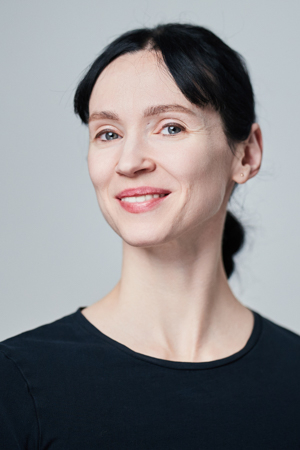
13 January 2026 |
Olesya Novikova creates tragic images, intense in eddies of emotion and the pain of losses. The cascades of leaps, spins, light jumps and the unexpected bravado foreshortenings appeared to be an impetuous improvisation. Not just in the dance episodes but in each outwardly static pose one felt the stormy inner dynamism and the spiritual expression.
Sankt-Petersburgskie Vedomosti
Olesya Novikova has emerged as a stunning ballerina: the semi-tones, the lively and meaning-filled body, the bewitching plastique. And that supreme perfection of technique when its perfection is not demonstrated but understood in its own right.
Nezavisimaya Gazeta
The utter dazzle of form and the acting content of the spectacle, in the fullest sense of the word, were led by Olesya Novikova. Everything was just as it should be – both the romantic first part, where the ballerina was the ethereal sylph, and the technically demanding second part, with its complex adagio, its incredibly beautiful and swift chaînés and its sharp, immaculate fouettés.
PRO Dance
• Recipient of the Benois de la danse prize (2024)
• Prize-winner at the International Vaganova-Prix Ballet Dancers’ Competition (St Petersburg, 2002).
Born in Leningrad.
Graduated from the Vaganova Academy of Russian Ballet in 2002 (class of Marina Vasilieva, Honoured Artist of Russia).
Joined the Mariinsky Ballet upon her graduation. Principal since 2021.
Repertoire at the Mariinsky Theatre includes:
La Sylphide (the Sylph); choreography by August Bournonville, revised version by Elsa-Marianne von Rosen,
Giselle (Nikia, Giselle); choreography by Jean Coralli, Jules Perrot and Marius Petipa,
Le Corsaire (Gulnare); production by Pyotr Gusev after the composition and choreography of Marius Petipa,
La Fille du Pharaon (Aspiccia); choreography by Marius Petipa reconstructed by Toni Candeloro,
La Bayadère (Gamzatti); choreography by Marius Petipa, revised version by Vladimir Ponomarev and Vakhtang Chabukiani,
The Sleeping Beauty (Aurora, La Fée Miettes qui tombent, La Fée Coulante, fleur de farine, La Fée d’Or fin (Gold), La Fée d’Aegent (Silver)); choreography by Marius Petipa, revival of the 1890 production by Sergei Vikharev,
The Sleeping Beauty (Aurora, Generosity Fairy, Silver Fairy); choreography by Marius Petipa, revised version by Konstantin Sergeyev,
Swan Lake (Odette-Odile, Pas de trois, Cygnets); choreography by Marius Petipa, revised version by Konstantin Sergeyev,
Raymonda (Raymonda, Grand pas, Variation); choreography by Marius Petipa, revised version by Konstantin Sergeyev,
Le Réveil de Flore (Flore); choreography by Marius Petipa, reconstruction of the 1894 production by Sergei Vikharev,
Don Quixote (Kitri, Flower Girl, Variation in Act IV); choreography by Alexander Gorsky,
Chopiniana (Nocturne, Seventh Waltz, Mazurka, Eleventh Waltz), Le Spectre de la rose (the Girl); choreography by Michel Fokine,
The Fountain of Bakhchisarai (Maria); choreography by Rostislav Zakharov,
The Nutcracker (Masha); choreography by Vasily Vainonen,
Romeo and Juliet (Juliet); choreography by Leonid Lavrovsky,
Études; choreography by Harald Lander,
Marguerite and Armand (Marguerite); choreography by Frederick Ashton,
Manon (Courtesan); choreography by Kenneth MacMillan,
George Balanchine’s ballets Apollo (Polyhymnia), Symphony in C (Third Movement), The Four Temperaments, Jewels (Emeralds, Rubies, Diamonds), Piano Concerto No 2 (Ballet Imperial), Theme and Variations and Tchaikovsky Pas de Deux,
The Legend of Love (Shyrin); choreography by Yuri Grigorovich,
Carmen-Suite (Carmen); choreography by Alberto Alonso,
Hans van Manen's ballets Adagio Hammerklavier, 5 Tangos,
The Nutcracker (Masha); production by Mihail Chemiakin, choreography by Kirill Simonov,
Middle Duet and Anna Karenina (Anna Karenina),
William Forsythe’s ballets The Vertiginous Thrill of Exactitude and In the Middle, Somewhat Elevated,
Ondine (Ondine, Naiads); choreography by Pierre Lacotte,
Without; choreography by Benjamin Millepied,
Le Parc; choreography by Angelin Preljocaj,
Coppélia (Swanilda), 12 (couple in the window); choreography by Alexander Sergeev.
Repertoire also includes:
Les Noces; choreography by Bronislava Nijinska,
Grand pas classique; choreography by Viktor Gzovsky,
The Meek One (the Meek One); choreography by Donvena Pandoursky,
Flight of Angels (Soloist); choreography by Edwaard Liang,
Du Côté de chez “Swann”; choreography by Alexei Miroshnichenko
and Nirvana; choreography by Emil Faski.
She created the female role in Alexei Miroshnichenko’s Du Côté de chez “Swann”, premiered at the VI International Ballet Festival MARIINSKY (St Petersburg, 2006).
In 2011 at the Teatro alla Scala she appeared in the lead role in the premiere performance of the ballet Raymonda (production by Sergei Vikharev). As a guest soloist she appeared in the performances of the Mikhailovsky theatre, Opera di Roma.